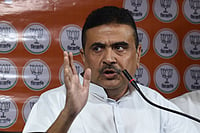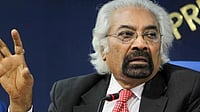The fat boy has returned to haunt budget-makers—a 400-pound giant who must be fitted into an average-size suit. For dream-weaver Palaniappan Chidambaram, this could turn out to be his worst nightmare. Only February 28 will tell whether his scissors and blue pencil have succeeded in making some magic.
Signals from North Block indicate that PC has had a fair degree of success in meeting his own budget targets. But, dear reader, wait a while before you get the happy face on. This consolidation has to help him build on his grand plans of tax and administrative reforms. So, even if he won't go for your jugular, your tax burden is set to rise.
Strong foreign capital inflows and budget hopes sent the Sensex to a dizzying 6679 points on Monday. Foreign investors have put in a net $1.2 billion already into Indian stocks in 2005, after delivering a record $8.5 billion last year. The market is betting that the budget will speed up liberalisation by lifting fdi caps in banking, retail and media and will continue with the thrust on infrastructure, power and tax reforms.
"I hope I'll have as many friends 18 days from now as today," PC told industrialists at an International Chamber of Commerce (ICC) meeting on February 10. Post the ITC excise ordinance, he perhaps has a few doubts. Of course, some might say, with leftist friends like Prakash Karat and A.B. Bardhan, he doesn't even really need enemies!
But PC's efficient macro-management is set to win him a round of applause, even if his tax proposals cause some brows to furl. But then, don't all budgets raise the tax onus on the average citizen every year? Even as income-tax rates have fallen compared to those in the mid-'90s, the huge expansion of the services tax net has raised cost of living all around. Some 73 services are taxed though 63 more, including legal and medical services, rail and air travel, are still untouched. Some of these will surely come under the net next fiscal, but there are doubts over whether PC will take the unwelcome step of raising rates from 10 per cent to 12 per cent or so again.
To raise revenues and to satisfy the economists who keep barking up the low tax-GDP ratio tree—the wrong tree, to many minds—PC's obvious choice is service tax. Indian taxes amount to nine per cent of GDP, nearly unchanged for a decade and much less than, say, 20 per cent in Brazil, another large developing economy. Ajit Ranade, chief economist, Aditya Birla Group, explains it very well. "The logical thing to do," he says, "is to expand the service tax net. Why? Simply because historically, the tax burden has disproportionately fallen on industry. The bulk of the taxes are paid by industry which contributes only a quarter of the GDP, while agriculture and services together now make up the rest. This is skewed and must change. But since taxing farm income is both politically sensitive and tough to administer, the services sector has to bear a fair burden, and this is what the FM is likely to continue to do." Remember, services account for half of GDP but supply only five per cent of gross tax receipts of about Rs 32 lakh crore.
As for income tax, carrots and sticks offer the ideal way of reform. For instance, the budget may consider withdrawing a few small savings exemptions while upping the income slabs of Rs 1 lakh, Rs 1.5 lakh and Rs 2 lakh, each by Rs 50,000 or Rs 1 lakh. This is only fair because, says the FM's economic advisor, Partha Shome, tax rates must be linked to inflation (if we look at it historically, the slabs that we have now signify higher burden than before). If that is done, it will minimise disappointment with the other part—we've been waiting so long for tax exemptions to go that their actual announcement might even come as a relief.However, the much-speculated tax amnesty scheme may not finally make an appearance. Expect instead good infrastructure investment schemes. Experts are also hoping that the proposal for an infrastructure company (special purpose vehicle) to attract private capital shall not be pushed through hastily.
Along with low rates, an improved and computerised tax administration system—the basis of which is a computerised Tax Information Network (TIN) run by the National Securities Depository Ltd (NSDL)—has helped raise total income tax collections in a big way. No less than an average 17 per cent growth in the past three fiscals, from
Rs 68,305 crore in '00-01 to Rs 1,03,255 crore in '03-04. Last year's over-performance encouraged PC to set a target of 35 per cent rise over the revised estimates of 2002-03. Till December, he'd managed a 30 per cent hike in corporate and 22 per cent in income tax. Not a bad show at all, considering a lot of tax monies arrive only at year-end.
Good corporate performance has also played a part in raising corporation tax inflows. Since the basis of tax reforms is to simplify tax codes, lower rates, widen the base and improve compliance, industry says it won't mind paying a net 30 per cent corporate tax as long as the distortions go. Chidambaram is expected to cut tax paid by companies by 2-3 points from 35 per cent now, while taking away some tax breaks—exemptions bring the effective corporate tax rate to only 22 per cent now. Anyway, an end to depreciation benefits on capital and machinery is long overdue as, according to many economists, they have served to bias businessmen in favour of capital against labour—a suicidal thing for a labour-surplus economy. Many even blame the stagnation in manufacturing sector employment on this.
Industry wants a tempering of indirect taxes too, which make up 32-44 per cent of the retail price as against 16-18 per cent in ASEAN or EU. In customs, there may be the usual five-point cut in the peak tariff, while the major indirect tax reform will come with the introduction of the 12.5 per cent VAT in states. Siddhartha Roy, Tata Group economic advisor, feels that "our end objective is to move towards a combined goods and services tax, or an integrated VAT with the necessary abatements. Unless we do that, inflationary pressures can build up and hit demand, and higher rates or taxing more services may not give us the desired result. If demand remains buoyant, tax collections can go up even with the same or lower rates. Thus, the average cenvat rate needs to be brought down by at least four points, to compensate for changes in the service tax side."
He's right, because a consistent services growth of nine per cent has allowed even super-high tax targets to be met. Former senior economic advisor Arvind Virmani recommends a 15 per cent unified cenvat with exemptions for all food and health items because the poor spend most of their income on these. Whatever shape it takes, VAT is important because it will mark the first step of the journey to wipe out state boundaries and make India a common market. It will also wipe out the inequities and inadequacies of excise. Says M.G. Rao, member of the VAT committee and director of the institute which has prepared all the subsidy papers, nipfp: "Incentives came because our tax system was designed to promote a socialistic society. Thus excise incentives served to distort our manufacturing economy and didn't allow small industry to grow. Area-based exemptions, in both corporate tax and excise, have actually skewed development. Then there are the ad valorem taxes for many commodities which serve no purpose. These have also increased disputes and litigation. VAT will eliminate these distortions, add to the TIN and foster a cost-efficient economy."
PC is also on target in customs and services tax, despite a huge hike in target in the latter. But the major slippage will be in excise which has achieved only 57 per cent of its target in nine months. Will that wreak havoc on the deficit targets? Far from it, says Saumitra Chaudhuri, ICRA economic advisor and member of the PM's economic advisory council. On the contrary, he expects PC to keep to his fiscal target and exceed revenue deficit figures only marginally. Instead of the targeted Rs 76,171 crore of revenue deficit at 2.5 per cent of GDP, fiscal 2004-05 may end with Rs 85,000 crore-odd, or about 2.7-2.8 per cent of GDP.
Now, this is no mean feat, especially under the shadow of the many government-funded schemes warranted by the CMP, but one which is unavoidable under the self-regulatory Fiscal Responsibility and Budget Management Act. According to Jagadish Shettigar, of the BJP economic cell, "One of the major pressures on the FM is his commitment to wiping out the revenue deficit by 2008-09." But this year's achievement is also creditable because a lot of the social sector outlays come under revenue expenditure and therefore must have been tough to keep down!
In fact, the economy has been reaping the benefits of improved fiscal discipline in recent years. Savings rate has topped 28 per cent, one of the highest among developing countries (though it pales when compared to China's 40 per cent), which in turn has raised gross domestic capital formation to 26 per cent. This will hopefully lead to growth, even though the savings-capital gap implies a lot of idle resources.
Better fiscal management also keeps the inflationary pressure down. Both VAT and service taxes could raise overall cost of living—at least for the high wage-earners and consumers of specialised services—but then, the price level is a mix of many things. Ranade argues that since service tax is applicable on non-discretionary services like health and legal or even getting a haircut, only some consumers will need to pay more. Chaudhuri says that since the tax is on only final consumption services which is 14 per cent of GDP, it's inflationary impact is marginal.
Best of all, this year's fiscal efficiency will allow PC that much leverage and potential to raise his social sector spending—the biggest thrust of the budget, according to senior North Block sources. For many of these pet projects—the irrigation and employment schemes, for instance—some money can be reshuffled and prioritised out of existing allocations. For the rest, food and fertiliser subsidies may need a relook. If that happens, PC will have finally done something for the poor, instead of merely being seen to be doing so. Keep your fingers firmly crossed on that.
The Fat Man Tries On The Slim Suit
And he doesn't look too bad. Finance minister Chidambaram seems to have got the cut right, so should one complain if the services cost a bit more? A taxing thought.

The Fat Man Tries On The Slim Suit
The Fat Man Tries On The Slim Suit
Published At:
MOST POPULAR
WATCH
MORE FROM THE AUTHOR
×





















